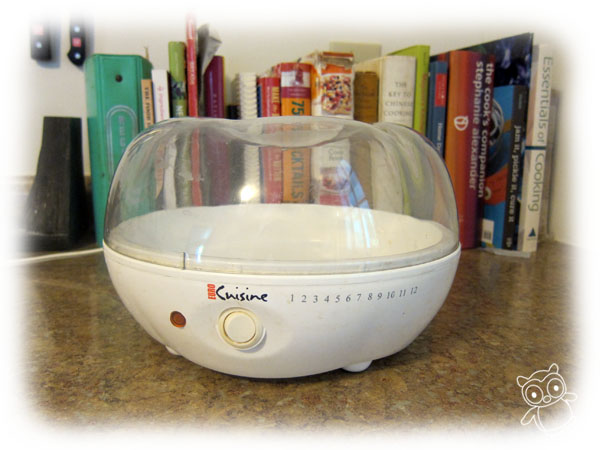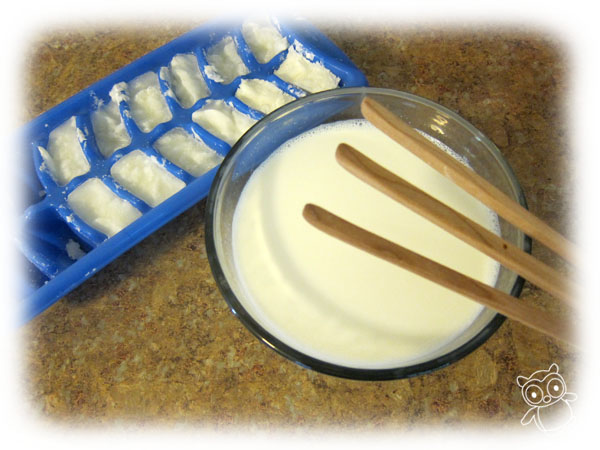I never thought so many people would be interested in my yogurt-making! I make my own yogurt (once a week, if you’re curious), and every time I mention it, I get requests for a tutorial. So… here it is!
It’s not hard to do! And for folks like me (who like plain yogurt, or even flavored yogurt without lots of sugar), making your own can be easier than finding the one you like in the store. Making your own yogurt is also cheaper than buying it, although not by as large of a margin as other homemade items (like bread, for example).
The Equipment
To make yogurt, all you need to do is add a culture (ie. friendly bacteria) to warm milk and keep it at 120 degrees (f) for 6-8 hours.
There are various pieces of equipment available to help you achieve the required temperature. You can use:
- a crock pot
- your oven (if the temperature setting goes low enough)
- a yogurt maker
I use a Euro Cuisine Yogurt Maker, and I love it. It keeps the temperature just right (as well as the humidity) and it doesn’t use much energy to run.
It’s important to note that a ‘yogurt maker’ doesn’t ‘make’ the yogurt (in the way that you dump ingredients into a bread machine and get a finished loaf of bread), it just keeps the mixture you’ll make at the right temperature for it to turn into yogurt.
Some people balk at having a yogurt-making appliance, but I don’t have a crock pot and my attempts at using the oven have been unsuccessful. So, it works for me. You’ll have to find what works for you!
The culture
You also need some happy bacteria to start your yogurt. The easiest thing to do is buy a small plain yogurt from the store, and divide it up into ice-cube trays and freeze:
You can also find culture in powder form, but I haven’t personally tried that approach.
How to make yogurt
Step 1: Heat your milk to almost boiling
Heat the volume of milk that you want to become finished yogurt (which probably depends on the size of your vessel).
If the milk boils a little, it’s okay. But, try to turn the heat off before it becomes a rolling boil.
Step 2: Let the milk cool
Now, let the milk cool to 120 degrees. Some folks use a thermometer, but I just stick my finger in and see if it feels like a nice bath temperature. If you skip this step, the too-hot milk will kill your bacteria.
Step 3: Add your culture
Whether you’re using the ‘ice cube’ method, fresh yogurt or powder, add the culture in and stir with a whisk. Use about 1 tablespoon (or two ice cubes) if using yogurt as a starter.
Pour the mixture into your vessel. I, personally, found the little jars that came with my yogurt maker too difficult to clean, so I use a glass storage bowl that fits inside my yogurt maker.
Step 4: Keep warm for 6-8 hours
Using a yogurt maker, this is easy. Turn it on and wait!
Step 5: Refrigerate and enjoy!
When your yogurt is done, it should look like yogurt. You know, solid-ish stuff with some liquid on top:
Draining the liquid is how you make Greek yogurt, but I like mine just this way. Refrigerate, and then enjoy!
Best,
Stacey











Wow! I was thrilled with the pizza baking and now excited with the yogurt making! I didn’t know Greek yogurt was a thing, though! Waiting for yor next kitchen achievement, Stacey!
Greek yogurt is a hugely popular craze! Is yogurt in Greece fairly thick? Or is this an American marketing scheme? 🙂
Traditional yogurt is indeed thick, both in taste and in fat, it can be 8-10% fat! No daily diet can accept that! But it’s so delicious! I had no idea it was popular outside Greece, though!
Yup, that sounds like our ‘greek yogurt’! Our traditional yogurt is runny and lower fat (or no-fat) in comparison.
Check out these Greek Yogurts 🙂
http://www.oikosyogurt.com/
http://chobani.com/
Almost every yogurt company has a ‘Greek’ one because they’re so popular!
Amazing! I had no idea!
The first one has even got a Greek name!
Wow! Based on your review, I just ordered myself the same yogurt maker. No more worries about what goes into it and what to do with all those plastic containers – can only reuse/recycle so many. Thanks Stacey! Can’t wait to make my first batch.
Hahaha… I know what you mean about the containers!
I’ll take Greek yogurt over “regular” any day: thick, creamy & a little extra tang. Mmmmm!
Thanks for the tutorial! I had no idea yogurt making was so simple! I am curious though…you mention that after the milk has cooled to 120 degrees or so you add about 1 tablespoon of starter. So that’s 1 tbsp per how much milk?
I make about 6 cups of yogurt, which is 6 cups of milk and 1 tablespoon. I think that since the starter ‘grows’, you don’t have to be exact… but if you were making, say, a gallon of yogurt, then you’d want to add more starter.
Any tips for making yogurt in a bread machine: my holiday gift came w/o a cookbook, only a manual! Thanks
I love making yogurt too!… I add some powdered milk into the mix also,,, it makes it creamier and thicker,, and a little extra protein…
Big smile for this blog! The ice cube tray tip is genius. Eager for the weekend to come so I can make yogurt and crochet at the same time. 🙂 thank you!
Do you thaw the cubes out before you use them? I am surprised that freezing doesn’t kill the bacteria. I have a yogurt maker but have not tried it yet!
Nope, I don’t thaw the cubes! I just drop them in the warm milk, and they melt 🙂
Stacey, do you know if yoghurt can be made with soy milk?
I don’t think it works according to the exact same technique. Obviously, soy yogurt exists (because I see it in the store), but this technique cultures bacteria in cow’s milk, and I don’t think soy reacts the same way. I would google around… there have to be a few tutorials!
Thank you for this post, Stacey. I’ve developed abdominal problems and need to drink Kefir and eat yoghurt. I’ll look for a yoghurt maker. This is great. Glad to have your recipe 🙂